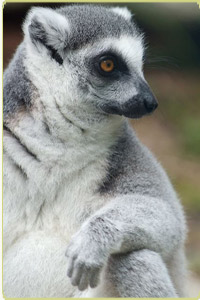Mammals vary in size from the 100-foot-long blue whale to the two-gram bumblebee bat, one of the world's most endangered species. Most mammals measure less than one foot (including the head and body). That makes small mammals far more common, if less well known, than large mammals like elephants, tigers, and people.
Small mammals cut across categories. Most species are rodents (such as the naked mole-rat), insectivores, and bats, but there are also carnivores (such as slender-tailed meerkats), and primates (such as golden lion tamarins and lemurs).
Tenrec and Elephant-shrew Born at Small Mammal House
 A greater Madagascar tenrec (at right) and a black and rufous giant elephant-shrew (or sengi) were born at the Zoo's Small Mammal House in June. They are both growing fast. In late July, the tenrec weighed nearly half as much as its father. Keepers have not yet able to weigh the sengi, but these animals reach adult size by the time they are six weeks old. Both babies are on exhibit with their parents.
A greater Madagascar tenrec (at right) and a black and rufous giant elephant-shrew (or sengi) were born at the Zoo's Small Mammal House in June. They are both growing fast. In late July, the tenrec weighed nearly half as much as its father. Keepers have not yet able to weigh the sengi, but these animals reach adult size by the time they are six weeks old. Both babies are on exhibit with their parents.
![]() See photos and learn more about elephant-shrews born in April.
See photos and learn more about elephant-shrews born in April.
Small Mammals, Inside and Out
The Zoo's Small Mammal House is home to more than two dozen species. Most of them can be seen in indoor exhibits but now that spring has arrived, several of them have been moved to outdoor exhibits, behind the House. Visitors should be sure to walk around the building and check out the black howler monkeys, prevost’s squirrels, golden lion tamarin, and red panda.
Black-footed Ferret Conservation
Earlier this year, Zoo scientists artificially inseminated five ferrets at the Zoo's Conservation and Research Center, in Front Royal, Virginia, and are eagerly awaiting the birth of kits this month. Thirteen other females bred naturally, and several of them had kits (baby ferrets). The ![]() ferret on the web cam below was artificially inseminated in mid-May. Staff learned in late June that she was not pregnant.
ferret on the web cam below was artificially inseminated in mid-May. Staff learned in late June that she was not pregnant. ![]() Find out more.
Find out more.
About the Golden Lion Tamarin Cam: The exhibit shown on the cam is undergoing maintenance, and the tamarins have been temporarily relocated. They should be back by mid-summer.
![]() North America Photo Gallery |
North America Photo Gallery |
![]() Help with cam
Help with cam
Can’t see any animals?
The animal in this exhibit may have moved out of view. FONZ volunteers operate some cams, but most of our cams show a fixed view.
Watching a black-footed ferret:
You are viewing the nest box of a litter of six black-footed ferrets and their mother, Cyan at the Zoo's Conservation and Research Center, where ferrets are bred to be saved from extinction. This year, more than 35 ferrets were born here. The kits on the cam were produced by natural breeding and born on June 20. Ferrets, which once ranged across the Great Plains and are now one of the world's rarest mammals, are more active at night—don't be surprised if the ferrets on camera are asleep.
![]() Recovery of the endangered black-footed ferret |
Recovery of the endangered black-footed ferret | ![]() Black-footed ferret facts
Black-footed ferret facts
Naked Mole-rat
Vet Stories: A Porcupine's Tail
Soon after Winnie, a prehensile-tailed porcupine, arrived at the Zoo in 2004, her keepers discovered that the end of her tail was injured. ![]() Find out how the vets and other staff treated her.
Find out how the vets and other staff treated her.
Mammal Mystery
Family members of this species greet with what looks like a kiss. They're not really kissing, but gently touching their front teeth together. ![]() What animals recognize each other this way?
What animals recognize each other this way?
Golden Lion Tamarin Conservation Program
 For
more than 30 years, this program has been saving these small monkeys
through conservation breeding and reintroduction to
their natural habitat in Brazil. Thanks to the success
of the program, the status of GLTs was downgraded from
"critically endangered" to "endangered" by the World Conservation Union (IUCN) in 2003.
For
more than 30 years, this program has been saving these small monkeys
through conservation breeding and reintroduction to
their natural habitat in Brazil. Thanks to the success
of the program, the status of GLTs was downgraded from
"critically endangered" to "endangered" by the World Conservation Union (IUCN) in 2003. ![]() more
more




